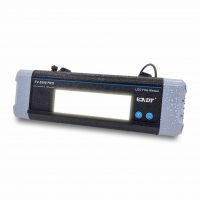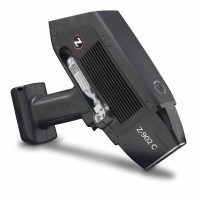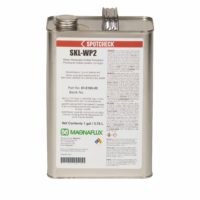
The JME portable X-Ray Betatron 7.5MeV is designed to produce high energy ionising radiation for industrial radiographic non-destructive testing. It can penetrate 30 centimeters of steel or 1 metre of concrete. Case study provided by JME Advanced Inspection Systems.
PROJECT OVERVIEW
An oil and gas pipeline operator contacted Oceaneering because an in-line inspection (ILI) pig was stuck in one of its pipelines in the North Sea. The pig had broken, and while one portion was recovered at the onshore reception facility, the rest remained stuck at an unknown position within the pipeline and was preventing oil production to the onshore terminal. The pipeline was suspected to be full of crude oil and wax deposits.
ISSUES
Production disruption meant large revenue losses, and the remediation plan needed not only an expedited solution, but one that had the best probability of positively identifying the missing pig’s location.
THE SOLUTION
There were no obvious known non-destructive testing (NDT) solutions available for obtaining non-intrusive inspection (NII) data or visual images of the pig with any confidence. However, radiography had potential as a viable option for targeted inspections.
Conventional radiography using high-energy gamma radiation was considered and ultimately rejected based on the method’s insu.cient penetrating power. The target areas of the pipeline included thick tee sections and complex non-return valves (NRVs). An additional consideration was the likelihood of the larger diameter pipe potentially being full of heavy crude wax.
Oceaneering was able to recommend JME’s Betatron high-energy X-ray system as a possible solution. The Betatron system, also known as a cyclotron, is normally used in a purpose-built exposure compound onshore to X-ray components with thicknesses up to 250mm. It is, however, seldom used for open site-based locations; one of the main challenges is assuring personnel safety during the operations and setting up a ‘Controlled Area’.
EXECUTION PLAN
The pipeline blockage was discovered in 2018; initial recovery operations using pressurization regimes and cleaning pigs were attempted during 2019. An unfortunate outcome of these intervention operations was that part of the pig broke off, but was recovered at the terminal pig trap. However, the fear was that other loose pig parts may remain in the pipeline along with the rest of the pig.
Oceaneering developed a timeline that included a data verification review using a similar data set from previous work involving a stuck pig and Betatron; pipeline exposures in our specialized facility at the Rosyth, U.K., dockyard; a presentation of the intended solution to the client; a detailed risk assessment of the site; and mobilization of equipment and specially trained personnel for the work from our head office in Aberdeen.
CHALLENGES
Several challenges presented themselves as the team prepared to execute the project plan, including:
- Radiation dose levels
- Stable power supply for Betatron
- Moist/salty air environment
- Scaffolding management
- Nucleonics
- Site personnel training
To resolve the challenges, the Oceaneering team put controls in place, lead sheeting, and collimation to attenuate the beam and test exposure to ensure radiation dose levels were properly managed. Special job-specific and site-specific local rules were adhered to, and a high-energy monitor adequacy trial was completed.
The team also ensured that adequate and stable power supply to the Betatron unit could be supplied by working closely with the site’s electrical supervisor to ensure that there would be no power output spikes.
To account for the moist and salty air environment, the team ensured that equipment was supplied with adequate covers and control habitat.
A scaffolding management protocol was implemented. This consisted of a lift plan and local manual handling and storage on the scaffold itself. The accelerator was stored in the transport case overnight. The team also installed a load-bearing overhead beam with shackle to support lifting. In addition, the group enlisted a specialized engineering design team for scaffold construction.
To ensure the beam did not affect nucleonic instrumentation, the team established precise beam control and collimation directed away from the pressure plant and equipment likely to be affected.
For safety and site personnel radiation awareness, the team conducted on-site training and toolbox talks.
The team provided daily scheduled calls to the site for project management fitness for service (FFS) input and image assessments from subject matter experts (SME).
To identify and inspect additional risks, the team conducted a daily risk assessment and perimetry regime.
RESULTS
 By using this innovative solution, the customer was able to resume pipeline production operations after only three months. We were able to positively confirm the pig position and the absence of pig debris in the tee prevention bars and inside the NRV. The pig’s location would have prevented valve closure or even caused damage to the valve internals during the closure which would have required a major pipeline intervention and workover to replace the valve. Around 20 m of pipeline was radiographed before eventually finding the pig. One of the main X-ray set-ups and actual X-ray digital image through the process thick wax product is shown.
By using this innovative solution, the customer was able to resume pipeline production operations after only three months. We were able to positively confirm the pig position and the absence of pig debris in the tee prevention bars and inside the NRV. The pig’s location would have prevented valve closure or even caused damage to the valve internals during the closure which would have required a major pipeline intervention and workover to replace the valve. Around 20 m of pipeline was radiographed before eventually finding the pig. One of the main X-ray set-ups and actual X-ray digital image through the process thick wax product is shown.
Contact us for more information on the JME PXB:7.5 Betatron.





